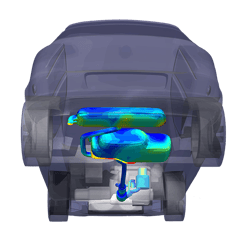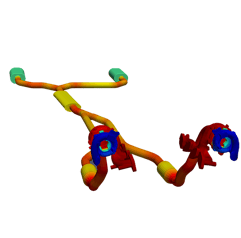With our newest software release comes one of the most powerful features to date, the addition of the Exhaust Extension. The Exhaust Extension will help you drive thermal management and heat protection for your most critical components, providing opportunities not only for cost-savings but also revealing new paths for product innovation.
Limit assumptions, get accurate thermal results
One of the biggest hurdles to understanding thermal management and heat protection for your exhaust system is the struggle to simulate accurate temperatures early in the design process. With more accurate temperatures, you will be able to simulate how your components will react under real-world circumstances and thereby create more efficient heat protection strategies for surrounding components. The trouble comes when you are picking a simulation strategy. CFD simulation processes take too long and are too costly to justify using them early in the design process and system modeling tools do not provide enough accuracy to allow you to see how the exhaust system will affect surrounding components.
It is for this reason we have developed the Exhaust Extension. The Exhaust Extension is the "goldilocks" solution – meaning that it provides the right amount of detail and accuracy to answer your design questions but runs quickly enough to deliver those answers in a timely manner for early design simulation. By placing this type of simulation at the beginning of your design process, you will save money and time, you’re your team will be able to model more design options and therefore be more innovative with their proposed solutions.
How can Exhaust Extension help?
With the Exhaust Extension, setting up your model is simplified using pre-built components: pipes, turbochargers, catalytic converters, a user-defined part, and (coming soon) mufflers. These parts are special in that they have personalized physics applied to them –how each part would react in a real-world environment is already accounted for. Effects such as surface roughness, pulsation effects, bend angles, entrance effects, and advanced pathfinding are simulated for these active components.
Along with these specialized components, Exhaust Extension is based around a localized convection model. This convection model utilizes an advanced pathfinding and centering algorithm to deliver accurate results within hours, instead of days. The Exhaust Extension also supports transient simulation to simulate temperatures over time as they would exist in the real world.
Remove the hurdle of starting with assumptions. Find a simulation strategy that allows you to start with an accurate thermal model. By understanding the complex reactions and environment of your exhaust system and its surrounding components earlier, you can create an optimized design more quickly. Creating a more efficient design process will also help you eliminate costs and frustration baked into a test-and-fix methodology.
In our next blog featuring exhaust, we will look at some of the challenges of modeling an exhaust system including developing methods for simulating dynamic, transient drive cycles.
If you are interested in how the Exhaust Extension can help you on your next project, schedule a demo with one of our technical sales reps. We can even set up a demo using your preferred geometry so you can how it would work with your specific project.
